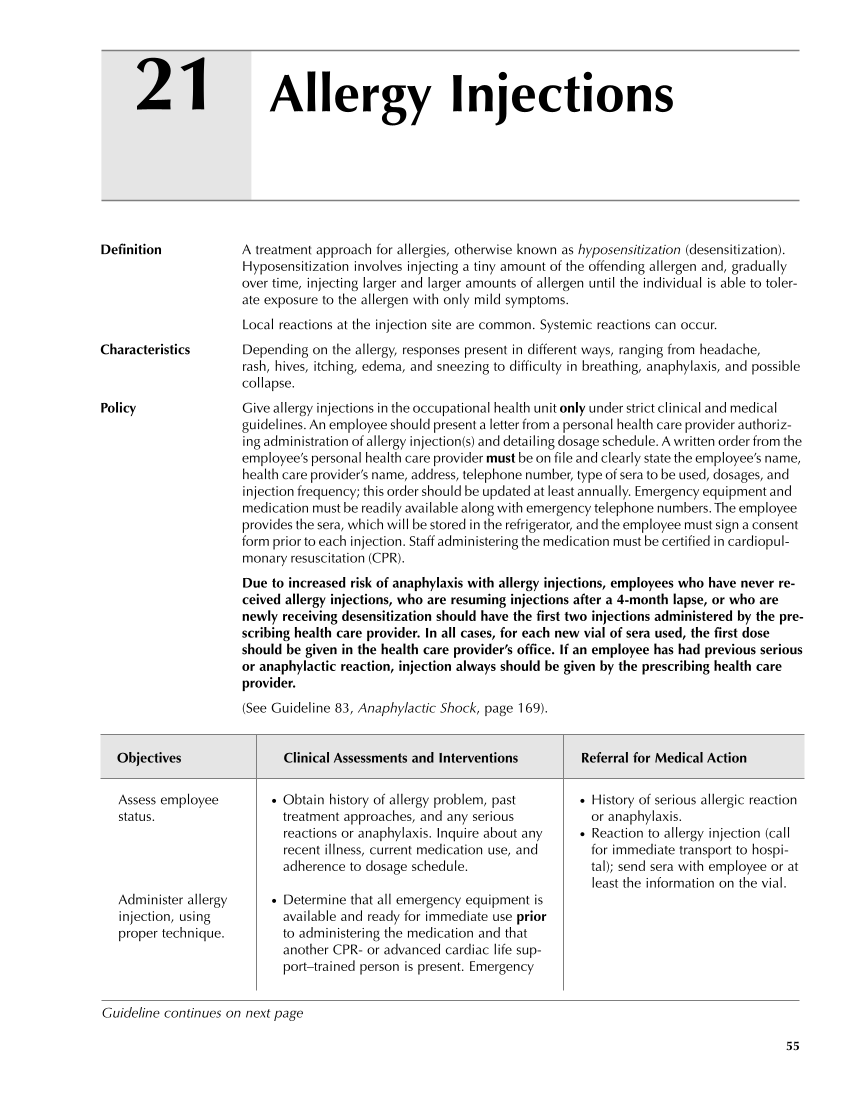55 Allergy Injections 21 Definition A treatment approach for allergies, otherwise known as hyposensitization (desensitization). Hyposensitization involves injecting a tiny amount of the offending allergen and, gradually over time, injecting larger and larger amounts of allergen until the individual is able to toler- ate exposure to the allergen with only mild symptoms. Local reactions at the injection site are common. Systemic reactions can occur. Characteristics Depending on the allergy, responses present in different ways, ranging from headache, rash, hives, itching, edema, and sneezing to difficulty in breathing, anaphylaxis, and possible collapse. Policy Give allergy injections in the occupational health unit only under strict clinical and medical guidelines. An employee should present a letter from a personal health care provider authoriz- ing administration of allergy injection(s) and detailing dosage schedule. A written order from the employee’s personal health care provider must be on file and clearly state the employee’s name, health care provider’s name, address, telephone number, type of sera to be used, dosages, and injection frequency this order should be updated at least annually. Emergency equipment and medication must be readily available along with emergency telephone numbers. The employee provides the sera, which will be stored in the refrigerator, and the employee must sign a consent form prior to each injection. Staff administering the medication must be certified in cardiopul- monary resuscitation (CPR). Due to increased risk of anaphylaxis with allergy injections, employees who have never re- ceived allergy injections, who are resuming injections after a 4-month lapse, or who are newly receiving desensitization should have the first two injections administered by the pre- scribing health care provider. In all cases, for each new vial of sera used, the first dose should be given in the health care provider’s office. If an employee has had previous serious or anaphylactic reaction, injection always should be given by the prescribing health care provider. (See Guideline 83, Anaphylactic Shock, page 169). Objectives Clinical Assessments and Interventions Referral for Medical Action ● History of serious allergic reaction or anaphylaxis. ● Reaction to allergy injection (call for immediate transport to hospi- tal) send sera with employee or at least the information on the vial. Assess employee status. Administer allergy injection, using proper technique. ● Obtain history of allergy problem, past treatment approaches, and any serious reactions or anaphylaxis. Inquire about any recent illness, current medication use, and adherence to dosage schedule. ● Determine that all emergency equipment is available and ready for immediate use prior to administering the medication and that another CPR- or advanced cardiac life sup- port–trained person is present. Emergency Guideline continues on next page
Purchased from OEM Press by (ge corporate access). (C) 2013 OEM Health Information, Inc. All rights reserved.












































































































































































































































































































































































































































